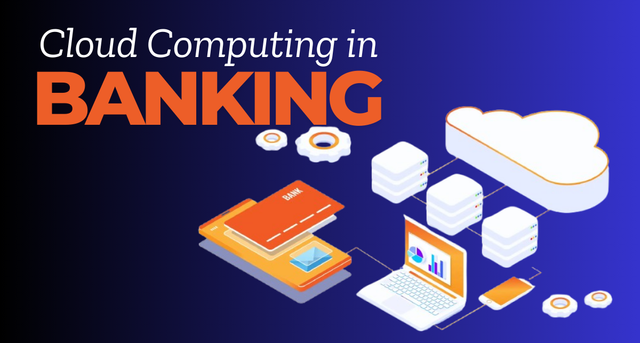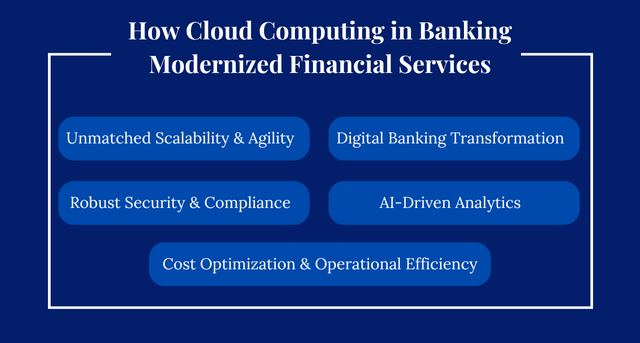Embrace Cloud Computing and Transform Traditional Banking into Agile Financial Services

Introduction
Banking has long been synonymous with monolithic institutions, rigid operational frameworks, and legacy infrastructure that resist change. But the tides are shifting. As financial institutions navigate a new era of digital transformation, cloud computing in financial services has emerged as a non-negotiable asset. Traditional banking is shedding its rigid structures, paving the way for agility, scalability, and efficiency—traits once deemed exclusive to fintech disruptors.
The financial sector is witnessing an unprecedented shift, where speed, security, and seamless operations are imperative. Cloud technology is not just an IT upgrade but a business transformation enabler. With global cloud spending in banking projected to exceed $180 billion by 2025 (Source: Gartner), banks are embracing the cloud to re-engineer their operations and elevate customer experiences.
This article delves into the transformative power of cloud computing and illustrates how it propels traditional banking into an era of automation, efficiency, and innovation.
Limitations of Traditional Banking Systems
For decades, legacy banking systems have operated on outdated, siloed infrastructure that slows decision-making and impedes technological evolution. The industry’s reluctance to modernize has resulted in:
- Inefficient Operations: Legacy systems require excessive manual intervention, leading to operational bottlenecks and higher costs.
- Limited Scalability: Expanding services or handling peak transaction volumes demands significant infrastructure investments.
- Cybersecurity Vulnerabilities: Outdated systems lack modern security protocols, making financial institutions prime targets for cyber threats.
- Regulatory Compliance Burdens: Banks operating on legacy infrastructure often struggle to comply with evolving regulatory standards.
- Customer Experience Gaps: Traditional banks risk losing relevance with modern consumers demanding instant, personalized banking experiences.
The solution? Cloud computing. Banks can enhance agility, boost security, and future-proof operations against emerging financial disruptions by transitioning from on-premises infrastructure to cloud-native solutions.
How Cloud Computing in Banking Modernized Financial Services
Introducing cloud computing in banking is not merely an IT enhancement but a strategic overhaul, redefining how financial institutions operate. Here’s how:

Unmatched Scalability & Agility
Cloud-based infrastructure enables banks to scale on demand, ensuring that spikes in transaction volume—such as during payday rush or Black Friday sales—don’t compromise performance. Unlike traditional models requiring costly hardware expansions, cloud banking allows institutions to adjust computing resources dynamically.
Cost Optimization & Operational Efficiency
Banks significantly reduce capital expenditures by eliminating the need for physical data centers. A study by Accenture reveals that cloud computing reduces IT operational costs by up to 40%, allowing financial institutions to reallocate budgets toward innovation and customer experience improvements.
Robust Security & Compliance
Financial institutions handle highly sensitive data, making security a top concern. Cloud platforms offer multi-layered encryption, automated compliance monitoring, and real-time threat detection, ensuring data integrity while adhering to strict regulations such as GDPR, PCI-DSS, and SOC 2.
AI-Driven Analytics for Personalized Banking
Cloud-powered AI models analyze customer spending patterns and financial behaviors in real-time, enabling banks to offer personalized loan recommendations, fraud detection alerts, and tailored financial planning services.
Seamless Digital Banking Transformation
Cloud computing underpins the mobile-first, digital banking era. Banks can deploy omnichannel banking experiences with cloud-based solutions, integrating AI-powered chatbots, real-time payment processing, and on-the-go financial services.
Case Studies of Successful Cloud Integration
Case Study 1: Bacancy Helps a National Bank Modernize Its Core Systems
Challenge:- 50% faster transaction processing speeds
- 30% reduction in infrastructure costs
- 99.9% uptime, ensuring seamless banking operations
- Full compliance with PCI-DSS, GDPR, and SOC 2 regulations
- 80% reduction in cybersecurity threats
- Improved customer trust and fraud prevention capabilities
Data Security & Privacy Concerns
Legacy System Integration
Regulatory Compliance Management
Banking as a Service (BaaS)
AI & Machine Learning in Financial Services
Blockchain & Decentralized Finance (DeFi)
- Agile operations that swiftly adapt to evolving market trends
- Cost-efficient scalability without heavy IT investments
- Superior customer experiences powered by AI-driven insights
A leading national bank grappled with outdated IT systems, slow transaction processing, and rigid infrastructure that hindered digital transformation.
Solution:Bacancy leveraged AWS cloud migration strategies, shifting the bank’s core banking services to a hybrid cloud model, ensuring low-latency transactions, automated disaster recovery, and regulatory compliance.
Outcome:Case Study 2: Bacancy Enables a Global Investment Firm to Enhance Security & Compliance
Challenge:
A multinational investment firm struggled with data security vulnerabilities and compliance issues due to its reliance on on-premises infrastructure.
Solution:Bacancy deployed a multi-cloud security framework, integrating zero-trust architecture and AI-driven threat detection. This enabled the firm to meet international banking regulations while fortifying cybersecurity defenses.
Outcome:Overcoming Challenges in Cloud Migration
Despite the immense benefits, cloud migration in banking has its challenges. However, strategic planning mitigates these risks:
Cloud security is a major concern, but leveraging multifactor authentication, end-to-end encryption, and AI-driven anomaly detection ensures that customer data remains protected.
Transitioning to the cloud while maintaining business continuity can be complex. A phased cloud adoption strategy minimizes disruptions and enables seamless migration of mission-critical banking applications.
Banks must adhere to stringent financial regulations. Partnering with compliant cloud providers like AWS, Azure, and Google Cloud ensures automatic compliance updates and risk mitigation.
Future Trends in Cloud-Based Financial Services
Cloud computing will drive the adoption of BaaS, allowing banks to offer third-party financial services through API integrations fostering open banking ecosystems.
Cloud-powered AI models will revolutionize credit scoring, fraud detection, and risk assessment, enabling hyper-personalized financial products.
Blockchain-backed cloud solutions will introduce faster cross-border transactions, smart contracts, and decentralized finance (DeFi) platforms.
Conclusion: The Future of Banking is Cloud-Powered
Traditional banking is undergoing an irreversible transformation. Cloud computing is no longer a luxury—it’s the cornerstone of digital banking evolution. Institutions that embrace cloud-native infrastructures gain an unparalleled competitive edge, ensuring:
The choice is clear—modern banks must evolve or risk becoming obsolete.
Want to future-proof your banking operations?
Discover how Bacancy’s Cloud Consulting Services can accelerate your digital transformation.